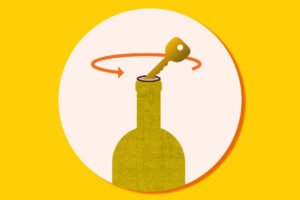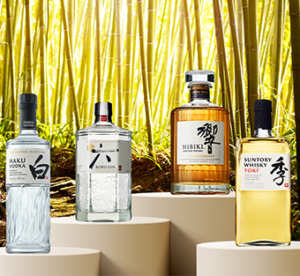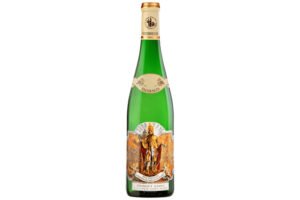Sake Raises the Stakes | Wine-Searcher News & Features

[ad_1]
Like Whisky, small-production, expertly crafted sake is now joining the game of high price tags.

© Sake Hundred
| The Sake Hundred labels are a masterclass in understated elegance.
Ryuji Ikoma worked in tech as a system integrator until the age of 25, when he decided to jump into two of the least lucrative jobs imaginable: starting up an online magazine about sake, and then creating small-production, artisanal sake.
Surprisingly, he didn’t grow up in the sake business.
“My friend had a sake shop. He taught me about sake,” Ikoma told Wine-Searcher via Zoom from Japan. “Before that I didn’t know much, and I was afraid of sake. But my friend’s sake was delicious.”
Ikoma is now publisher of saketimes, a free website in Japanese and English that attempts to teach young adults about sake. saketimes is expansive in its reach, which makes the focus of his sake-negociant company, Sake Hundred, the polar opposite.
Sake Hundred commissions small amounts of very expensive sake, and the high prices are themselves a marketing point.
“In the $40 or $80 class, we are not releasing that kind of sake,” Ikuma said. “We want to have our brand be a luxury brand. Everything we make is only one. If it’s easy to buy or easy access, we are not making it.”
Sake Hundred is the fanciest sake brand I’ve seen. Everything about it screams high-end. Start with the bespoke white box every bottle comes in, complete with a 28-page booklet and a separate small “care guide.” (TLDR: Refrigerate the sake.) There’s the unnecessary metal clamp on the bottle that gives it an artful farm-product image. From the care guide: “Due to the nature of the vessel this product is stored in, on very rare occasions the bottle may incur minor leakage when stored on its side.”
And then there’s the price: $380 for the entry-level Byakko Bespoke “Crystalline Brew.” There’s also a $435 oak-aged sake and a $3,100 aged sake with a great back story.
The pricing strategy worked on me because I wanted to know what a $380 sake tastes like (to be clear, my bottle was a press sample; we didn’t pay for it.) Why so expensive? Part of it is that the production process is expensive: the rice is polished to just 18 percent remaining, far less than most commercial sake. But even given that, it’s pricey.
Let me ask you a question: which is more interesting, the fact that it’s a Junmai Daiginjo sake made from Dewasansan rice in Yamagata prefecture, or that it’s $380? Be honest.
In fact, if it was about the polishing ratio, Ikoma could have joined the ongoing race to the smallest grain possible. He said that Tatenokawa brewery, which makes Byakko Bespoke for him, makes sakes from rice polished to as little as 0.8 percent. Imagine a winery throwing away 119 of every 120 grapes it harvests. But Ikoma says there actually is a limit to how low one can go.
“Polish is also equal to discarding the flavor,” Ikoma told Wine-Searcher. “So one percent didn’t have depth, and it was closed and hard. I wanted to have the sake open and very complex and rich.”
With that, he succeeded. Byakko Bespoke is made for the luxury wine market. This is not a light, ethereal Daiginjo: it’s rich and full-bodied, and aromatic enough that my wife knew in the next room that I had opened it. There’s green apple and white peach fruit. You might want to keep it cool because it starts to taste fairly sweet as it warms up, but it has the balance to handle it.
Ikoma said he sought Tatenokawa to make this sake for him because, unusually, the brewery makes only Junmai Daiginjo sake; nothing less polished. Oujiman, a brewery with the same owner, made Sake Hundred’s oak-aged “Shirin” sake, which I haven’t tried. He said they tried French and American oak before using Japanese mizunara oak from Hokkaido. There’s a chronic shortage of mizunara, which is popular with Japanese whiskey producers, so that’s also a luxury touch.
One lucky drop
The crazy expensive sake – $3100 a bottle – is called “Gengai.” It’s a remnant of 1995 production from Sawanotsuru brewery in Kobe prefecture. In January of that year, Kobe was hit hard by the Great Hanshin Earthquake, which reached 7.2 on the Richter scale and killed more than 6000 people. The brewery had to be abandoned with the sake halfway done. Unlike wine, normally sake cannot survive being left alone at that point in the production process.
“It was lucky sake because it survived the earthquake, but it was oishikunai,” Ikuma said. “Oishii” mean delicious; “oishikunai” literally means “not delicious,” but as a Japanese speaker I have to tell you that it’s an extreme negative. If you tell a chef that his sushi is “oishikunai,” you better hope he’s not holding a knife.
“Usually it would be thrown-away sake,” Ikuma said. “But Sawanotsuru’s policy is that sake is something you grow. They thought maybe aging might make it delicious. So ever since 1995, every year they tried the sake. After 20 years, they thought, it’s oishii.”
Sawanotsuru prepared 10 sakes for a blind tasting for Sake Hundred.
“Within those 10 sakes, there was Gengai,” Ikuma said. “But Sawanotsuru didn’t tell any back story. One of them was surprising. It was the kind of sake beyond my imagination. You can taste fruit and flowers. It’s three-dimensional. Now they have 3500 bottles worth left in tank. Every year we are making 500, so in theory after seven years it will be all gone.”
Ikuma said Sake Hundred’s future plans are to continue to make one or two sakes per year with different breweries.
“I don’t want to make too many,” he said. “I want to make everything be special.”
One way you can be sure of that is the high price you’ll pay.
To join the conversation, comment on our social media channels.
[ad_2]




